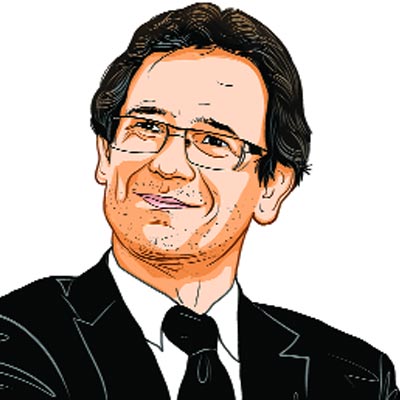The uniform code
Under-representation of Muslims in police and army hurts the constitutional project of multi-cultural India

Sixty-four per cent of Muslims are “highly” or “somewhat” fearful of the police. (Representational)
The recent ‘Status of Policing in India Report, 2018’ published by the Centre for the Study of Developing Societies and the NGO Common Cause — which has been hardly discussed in the media, unfortunately — offers a comprehensive survey of the performance and perceptions of the Indian police. We shall focus here on one aspect: The relation between Indian Muslims and the police. According to the report, while all minorities fear the police more than Hindus, the apprehension is more acute in the case of Muslims: Sixty-four per cent of them are “highly” or “somewhat” fearful of the police. No question was asked about the lynching of Muslims in the name of cow protection, which has often taken place in spite of, or in the presence of, the police, probably because the survey was made before this phenomenon gained momentum.
As a result, the main reason for this fear appears to be the fact that “police often implicates Muslims under false terrorism charges”. Indeed, there are many cases of young Muslims who have been to jail and even spent years behind the bars for this “reason”, before the judiciary, at long last, released them. In four states, Bihar, Maharashtra, Rajasthan and Tamil Nadu, 50 per cent or more of the Muslim interviewees say that police discriminates on the basis of religion.
This may be partly explained by the social profile of the policemen. The database we have compiled shows that Muslims are dramatically under-represented in the Indian Police Service (IPS). It has always been the case: Their share was already lower than 5 per cent in the 1950s, less than half the proportion of Muslims in Indian society according to the 1951 census. While the share of Muslims in the population subsequently rose, reaching 14.25 per cent in 2011, the proportion of Muslims in the IPS dwindled, falling beneath the 3 per cent mark in 2016, and even as low as 2.5 per cent of the whole service if Jammu and Kashmir is excluded from the calculation.
Never had the gap between the share of Muslims in the population and their share in the IPS been so wide. For a long time, Muslims were able to take advantage of the parallel track offered at the state level, through which police officers recruited by the state administration could join the IPS. But this recruitment channel has dried up: While 7 per cent were to be promoted in 2006, the number of Muslims fell to 3.8 per cent in 2016.
The situation is less unfavourable to Muslims if the analysis is broadened to include policemen at lower echelons. In 2013 — the last year for which the data was compiled, probably because the nation does not need to know — Muslims made up 6.27 per cent of policemen in India. But their strength was on the wane, as in 2005 they still comprised 7.5 per cent. The ‘Status of Policing in India Report 2018’ shows that between 2006 and 2013, Muslims were particularly underrepresented in law enforcement agencies. While the average index was 0.31 (compared to 0.50 for women), it varied between 0.08 in Assam and 0.69 in Andhra Pradesh, with only 0.09 in Rajasthan and 0.18 in
Uttar Pradesh.
Uttar Pradesh.
The national character of a nation-state is inevitably affected by the quasi-absence of the largest minority in a key institution like the police. But there are other uniforms, in the army, that Muslims do not wear in large numbers either. Again, the problem is not new. It harks back to 1947. That year, Partition led to the departure of virtually all the Muslim army officers to Pakistan. In 1953, India’s defence minister informed Prime Minister Nehru that the proportion of Muslims in the Indian Army had gone from 32 per cent in 1947 to 2 per cent. The Prime Minister then sent a circular saying: “…in our Defence Services, there are hardly any Muslims left. What concerns me most is that there is no effort being made to improve this situation, which is likely to grow worse unless checked”.
He was right. Muslims made up less than 1 per cent of higher-ranking officers (colonels and above) in 1981, according to Steven Wilkinson in his book, Army and Nation. This figure was confirmed in the late 1990s by the then defence minister, Mulayam Singh Yadav. The man who succeeded him in this position under the Atal Bihari Vajpayee government, George Fernandes, bluntly explained the situation: “The Muslim is not wanted in the Armed Forces because he is always suspect — whether we want to admit it or not, most Indians consider Muslims a fifth column for Pakistan”.
The situation there is once again less unfavourable if the analysis is not limited to senior officers but broadened to take into account the armed services as a whole. In the army, Muslims made up 2.5 per cent of the people in uniform in 1990-2000, particularly thanks to the Jammu and Kashmir Rifles, the Jammu and Kashmir Light Infantry and other companies such as the Rajput Regiment. Similar figures are found in the navy (1.9 per cent of Muslims in the higher ranking categories and 3.2 per cent in the others) and the air force (3.1 per cent of Muslims, including 0.9 per cent senior officers), according to the equally old data presented by Omar Khalidi in Khaki and the Ethnic Violence in India.
This data was recently updated by Ali Ahmed’s study on officers trained at the Military Academy. From 2005 to 2011, 2 per cent of them were Muslims, a figure confirming the one the Sachar Committee found in the army, 2.62 per cent. Figures for so-called “paramilitary” forces, which form an intermediary category between the police and the army, are in the same range — except, of course, when Muslims are simply barred from them, as is the case of National Security Guards in charge of combating terrorists. The Assam Rifles had 2.5 per cent Muslims in 1995-96, the Border Security Force, 4.5 per cent, the Central Industrial Security Force, 3.7 per cent, the Central Reserve Police Force, 5.5 per cent, the Indo-Tibetan Force, 1.8 per cent and the Rapid Action Force, 6.9 per cent.
That Muslims are not wearing the police uniform increases their vulnerability, but that they have been even more under-represented in the army since 1947 reflects a larger issue: By excluding the largest minority from the institution in charge of defending the nation, the state has undermined the project of a multicultural India enshrined in the Constitution and prepared the ground for the saffronisation of the public sphere. The infiltration of the institutions in charge of law and order and security by Hindu nationalists should probably be factored in too.
Jaffrelot is senior research fellow at CERI-Sciences Po/CNRS, Paris, professor of IndianPolitics and Sociology at King’s India Institute, London. Bhutada is an MA student at Sciences Po, Paris, School of International Affairs.
For all the latest Opinion News, download Indian Express App
More From Christophe Jaffrelot
- Coalition CountryWill India remain a civilisational-state, post 2019, or continue its march to a unitary, ethno-religious entity?..
- The same odd coalitionAnti-BJPism is propelling unlikely alliances today — just as anti-Congressism had done in the past..
- The segregated cityGhettoisation and Disturbed Areas Act are dividing urban spaces in Gujarat, pushing Muslims to the edge...







































No hay comentarios:
Publicar un comentario